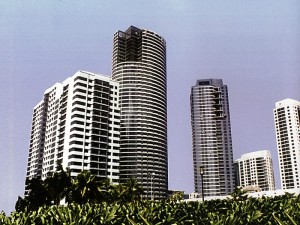Whistleblower architect calls for a ‘break’

ROCKWELL Center has been described as a technically innovative, pioneering masterplan focused on the development of a walkable and integrated community.
BREAKING FROM his recent role as a “whistleblower” of anomalous property developments, this maverick Filipino architect asks the public to give his own projects a long, hard look.
Felino “Jun” Palafox, the principal architect and managing partner of Palafox Associates, has been in the headlines of local news and even in cable news organizations such as CNN and BBC for being an outspoken watchdog of sorts, putting into light certain building and urban developers’ environment and safety violations.
Last week, he urged the media to look at his own firm’s projects to get a prime example of what he said were world-class but sustainable projects.
He described the 22-year-old Palafox Associates, manned by a team of 100 (70 of whom are architects), as an organization in the forefront of sustainable architectural developments worldwide with hundreds of projects in 32 countries—from aviation centers to places of worship.
Internationally recognized
Palafox Associates, he said, has been the only planning and design firm in the Philippines which has made it to the London-based World Architecture Magazine’s Top 500, Top 300 and Top 200 Architectural Firms in the World for the past eight years. The annual worldwide survey is internationally recognized as the most comprehensive survey of its kind. In 2006 Palafox Associates ranked 94th, breaking into the Top 100 and was the only Southeast Asian firm cited in the world’s largest practices.
Aside from building iconic projects such as the Rockwell Center, an inner city revitalization project, the Asian Development Bank, Torre Lorenzo, and Laureano di Tevi Towers which is a high-rise residential complex in Makati by Vistaland, Palafox related that his team had been involved in the architectural design of more than 11 billion square meters of building area. The company has also masterplanned over 100 communities, covering more than 7 million sq m of land area in different continents.
The Embassy of Qatar in Manila, the Philippine Embassy and Chancery in Brunei (referred by the Brunei media as the first green building in the country), the first SM mall in China, and the largest masjid in the country commissioned by the Sultan of Brunei in Cotabato are just some of the world landmarks that his group has had a hand in designing and building.
The Rockwell Center
Not everyone knows that his team was involved in the country’s first masterplanned integrated development, Makati’s Rockwell Center. It has been described as “a technically innovative, pioneering masterplan focused on the development of a walkable and integrated community for residence, work and play,” as discussed extensively in the coffeetable book “Architecture, Planning & Design: Palafox Associates The First Twenty Years.”
Undertaken from 1992 to 2000, Rockwell Center considers innovation and quality of life, creates a sense of place and affirms Palafox team’s advocacy for the environment.
He related how the group took up the challenge to transform a power plant into a functional site. The other challenge was to change its land use from an industrial power plant into a first-class, mixed-use development, “which was not yet within our zoning standards at the time.”
“These were new challenges and the positive element was our client, the late Eugenio ‘Geny’ Lopez Jr. Geny gave us a free hand in applying the best practices in architecture and planning in the Rockwell project.
“I remember the options we had: To do nothing and just sell the property was the basic option; the second was to design two-story residences similar to the ones found in the adjacent villages; and the third was to make high-rise, mixed-use development, live-work-play-shop-dine and worship in a walkable community, proposing about 15 variations of urban design and architectural concepts,” he said. He recalled how his company executed about 10 to 12 of those, and Skidmore Owings & Merril, who joined the project as Palafox Associates’ masterplanning and design consultant, did about five alternatives as well as developed the concept.
“While performing our architectural business, we want to bring our country to a first-world position by year 2020. We are talking here of sustainable developments and their positive effects on the environment, and how each project should enhance life quality in terms of comfort and neighborliness, income generation, and socioeconomic and cultural activities in the regional, national and international scenarios.
“Every project must elevate the international stature of Filipino professionals, be economically and financially viable, and enhance the environment for future generations,” he said.
Environment is one of the firm’s priorities as he often cited “we are merely borrowing our environment from future generations.”
He said that as a design and planning professionals, the firm takes a stand in protecting and enhancing the environment, making sure that the natural and built environments can harmoniously coexist first by looking at the bigger urban context of a location, conducting site analysis to be able to evaluate its characteristics and constraints and identify its development opportunities. These site details and constraints are balanced with the design concept.
